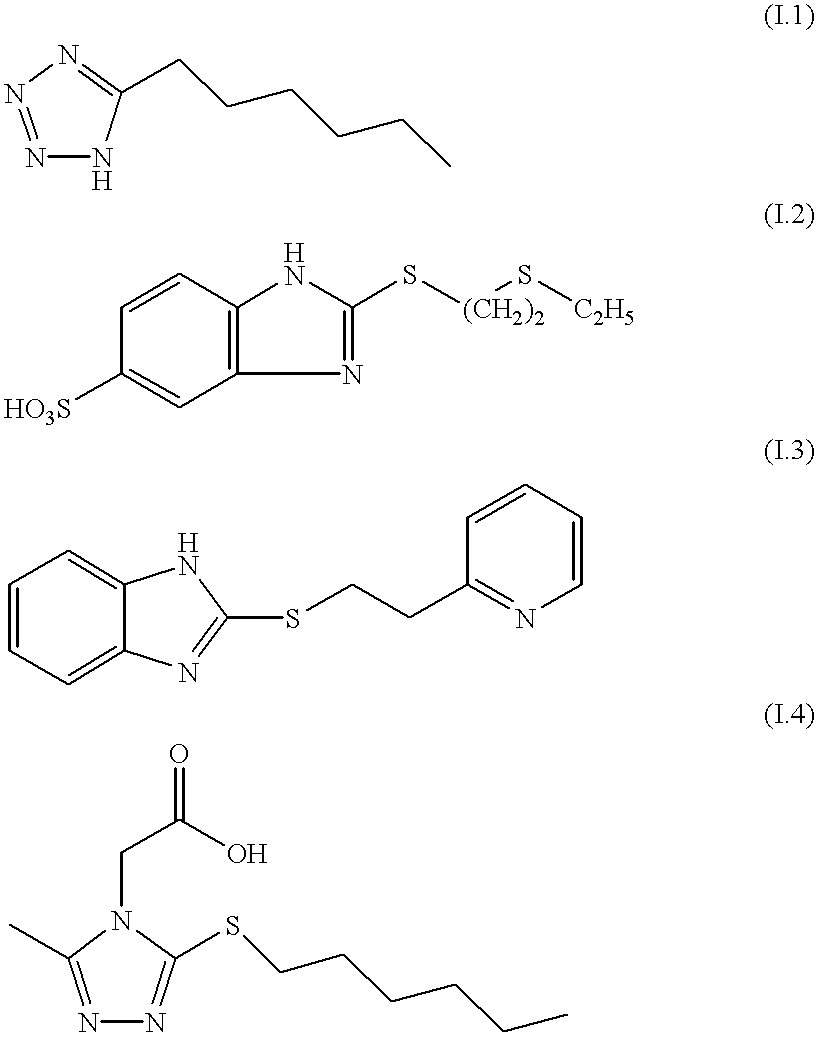Silver halide photographic material exhibiting increased covering power and "colder" blue-black image tone
a silver halide and photographic material technology, applied in the field of silver halide photographic material exhibiting, can solve the problems of unsatisfactory measures taken in order, combined with a good covering power, and it is impossible to traverse the normally expected relationship between improved covering power and worse image tone, so as to achieve the effect of increasing image tone and increasing covering power
- Summary
- Abstract
- Description
- Claims
- Application Information
AI Technical Summary
Benefits of technology
Problems solved by technology
Method used
Image
Examples
example 1
Preparation of Tabular Emulsion A
To a solution of 6.0 g of inert gelatin in 1.2 1 of demineralized water at 51.degree. C., whereto 15.5 ml of a solution of potassium bromide 2.94 N were added, stirred up to a rate of 400 r.p.m., were added by a double jet method aqueous solutions of 2.40 M AgNO3 (hereinafter referred to as Al) and 2.40 M KBr (hereinafter referred to as B1): at a constant rate of 34.8 ml / min. for Al and 34.8 ml / min. for B1, both solutions were added in a time interval of 28 seconds. During this period, the reaction mixture was maintained at 51.degree. C. The temperature was increased up to 65.degree. C. over a period of 12 minutes 27 seconds: UAg should be in the range from -18.+-.3 mV versus a Ag / AgCl(sat.) reference electrode at a temperature of 65.degree. C..+-.0.2.degree. C. Immediately thereafter the solution Al was added during 26 seconds at a rate of 3.75 ml per minute and UAg was controlled again and should be in the range of -10.+-.3 mV at a temperature of 6...
example 2
Preparation of Tabular Emulsion C
To a solution of 7.5 g of an oxidized gelatin in 1200 ml of demineralized water at 40.degree. C., adjusted to a pH of 2.5 by adding H2SO4, stirred up to a rate of 500 rpm., further containing 20 mmole of KI, were added by a double jet method aqueous solutions of 2.94 M AgNO3 (hereinafter referred to as A1) and 2.94 M KBr (hereinafter referred to as B1): 6 ml of A1 and 1.9 ml of B1 were added in a time interval of 30 seconds. During this period, the reaction mixture was maintained at 40.degree. C. When the addition was completed, stirring continued during 60 seconds and the temperature was increased up to 70.degree. C. over a period of 40 minutes. Immediately thereafter a solution of 25 g of inert gelatin in 100 ml of demineralized water of 70.degree. C. was added. 6 minutes later ultrafiltration was started on-line in order to reduce the volume in the reaction vessel and in the ultrafiltration unit up to 1500 ml per 500 g of AgNO3 present therein. By...
example 3
Preparation of Tabular Emulsion D
To a solution of 6.9 g of an oxidized gelatin in 3 l of demineralized water at 51.degree. C., adjusted to a pH of 2.5 by adding H2SO4, stirred up to a rate of 600 r.p.m., were added by a double jet method aqueous solutions of 0.98 M AgNO3 (hereinafter referred to as A1) and 0.98 M KBr (hereinafter referred to as B1): 25 ml of A1 and 25 ml of B1 were added in a time interval of 30 seconds. When the addition was completed, the temperature was increased up to 70.degree. C. over a period of 30 minutes: UAg was controlled (expressed in mV versus a Ag / AgCl(sat.) reference electrode and should be in the range from 44.5.+-.5 mV at a temperature of 70.degree. C..+-.1.degree. C. 1 minute later pH was set to a value of 5.0.+-.0.3 and immediately thereafter a solution of 50 g of inert gelatin in 500 ml of demineralized water of 70.degree. C. was added. 3 minutes later B1 was added at a rate of 7.06 ml / min. during 120 seconds, while simultaneously adding by doubl...
PUM
| Property | Measurement | Unit |
|---|---|---|
| grain thickness | aaaaa | aaaaa |
| equivalent volume diameter | aaaaa | aaaaa |
| grain thickness | aaaaa | aaaaa |
Abstract
Description
Claims
Application Information
 Login to View More
Login to View More - R&D
- Intellectual Property
- Life Sciences
- Materials
- Tech Scout
- Unparalleled Data Quality
- Higher Quality Content
- 60% Fewer Hallucinations
Browse by: Latest US Patents, China's latest patents, Technical Efficacy Thesaurus, Application Domain, Technology Topic, Popular Technical Reports.
© 2025 PatSnap. All rights reserved.Legal|Privacy policy|Modern Slavery Act Transparency Statement|Sitemap|About US| Contact US: help@patsnap.com



